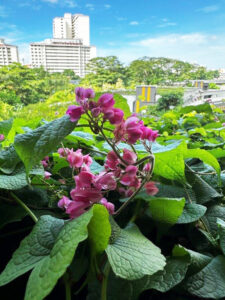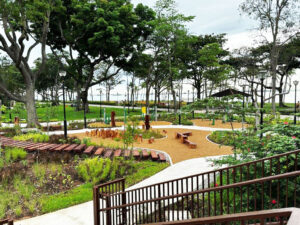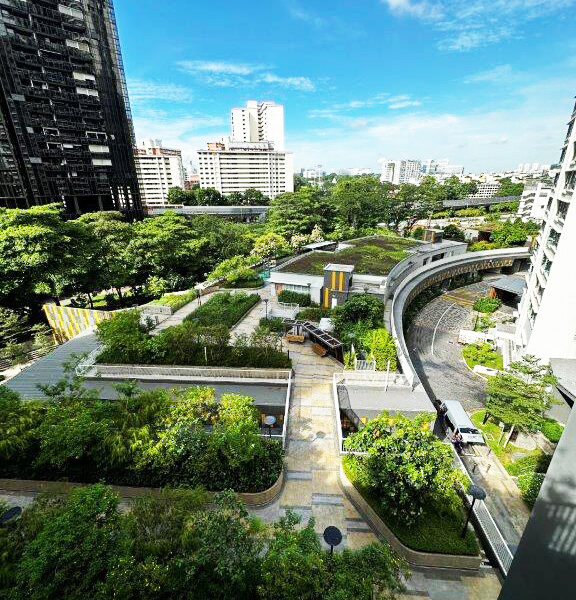Discovering tomorrow: Exploring the visionary landscape of nature-based cities
By Michael Casey
I’m captivated by the vibrant energy of cities, and harbour a deep love and respect for nature. However, when will we truly experience a merging of these two worlds, placing our profound need for plants at the forefront? It’s crucial to ensure that 55% of the world’s population finds genuine comfort in these urban landscapes. The call for cities to transform into nurturing, circular economies and energy-neutral sanctuaries is imminent, but it’s an important and required journey we need to make. We must pour our passion and knowledge into reimagining the roles of plants and other life forms in this revolutionary approach to city planning, infusing our urban spaces with life, vitality, and genuine connection.
Cities can be viewed as ongoing social experiments; vibrant laboratories where diverse populations interact, shaping and testing societal norms. Urban environments provide platforms for cultural, economic, and political experiments that reflect the complexities of human coexistence and the future of how we govern, live, and design our built environments. From architectural designs influencing community behavior to diverse neighborhoods fostering social integration, cities constantly evolve, adapting to, and influencing, human behavior. The urban landscape serves as a setting for experimentation in governance, technology, and sustainability. Challenges such as inequality and environmental sustainability showcase the ongoing social experiments within cities, highlighting the need for innovative solutions. In essence, cities embody the collective experiment of humanity navigating the intricacies of communal living. And amongst all this exists the need for plants to help with not only climatic issues but for the needs of all humans.

Creating cities that harmonise with nature is a compelling vision for the future; an interaction where urban landscapes and ecosystems merge seamlessly. As we embark on the journey towards nature-based cities, the integration of flourishing plant life emerges as a foundation towards a healthier world. Imagine strolling down avenues lined with trees, not just for aesthetic pleasure but for their role in purifying the air, offering shade, and providing a habitat for diverse species.
The viability of plant suitability in urban environments becomes crucial in crafting these green oases. From towering skyscrapers beautified with vertical gardens through to community parks adorned with a rich diversity of flowering plants, the architecture of nature-based cities seeks to cultivate an environment where flora thrives. The careful selection of plant species, considering local climate and soil conditions, ensures a resilient and sustainable urban greenery that can withstand the test of time. Horticultural excellence will be a tool other professionals will wish to seek, and holders of this education will be in high demand for their ability to understand what plants work in a changing environment. Biodiversity is something we touch on a lot now and it is fast becoming recognised as the lifeline for our future cities. Diverse ecosystems, ranging from rooftop gardens to urban wetlands, can foster a rich array of plant and animal life that will one day see our cities beaming with nature and healthy eco systems. This concept extends beyond traditional parks but embraces the relationship of different species within the urban fabric. Butterflies fluttering amidst wildflowers and birds finding refuge in urban forests all equates to a healthy web of life that paints a vibrant picture of coexistence between nature and city dwellers, along with numerous benefits that come from interacting with nature.
In this utopian cityscape, humans and animals are not mere cohabitants but active participants in a shared ecosystem. Rooftop apiaries invite bees to pollinate the urban gardens, creating a sustainable cycle of biodiversity. Wildlife corridors meander through the city, allowing animals to traverse safely. At present, we rely heavily on smaller patches of green in our city blocks that only create habitat patches and in turn, make the movement of animal life very difficult. Knowing what non-human life forms once inhabited these environments will also allow us more knowledge when designing green spaces for biodiversity. Choosing life forms to inhabit these spaces based on the likes and dislikes of species cannot be an option.
But more importantly, these green spaces must be a place where children grow up with a genuine connection to nature; where urban jungles are not concrete labyrinths but rather spaces teeming with life. These spaces provide children the opportunities to interact with nature like we have all been afforded.
Walking through these nature-based cities will be a sensory experience, with the fragrance of blooming flowers mingling with the sounds of birdsong, and the colours and textures of plant biodiversity providing visual attraction at every corner. Each neighborhood becomes a microcosm of ecological balance, with local flora and fauna uniquely adapting to the surroundings. The city needs to breathe and pulsate with life, and city dwellers will then become stewards of this living, breathing organism. Integrating community into both the design and management of our green spaces will allow for the sharing of education between experts and city dwellers, and the creation of community stewards to further protect our biodiversity.
The integration of green spaces isn’t solely for ecological reasons; it’s a mindful approach to mental well-being. Parks are designed not just as recreational areas but as havens for meditation, yoga, and moments of quiet contemplation. Stress dissipates amidst the rustling leaves, and the urban noise is replaced by the soothing sounds of nature. Imagine how calmer city dwellers will become with the sounds of nature drowning out the monotonous sounds of cars, machinery, and other noise polluting mechanisms. It has been noted through several studies that city noise, and the intensity of these noises, can make people quite sick making this case for quieter spaces much greater.

Consider a future where sustainable architecture merges seamlessly with the environment, where buildings are beautified with facades that support plant life and encourage the creation of ecosystems. These living walls act as both insulation and air purifiers, showcasing the marriage of functionality and aesthetics. Green roofs become standard, not as a novelty but as a practical solution to reduce the urban heat island effect, mitigating storm water surges and promoting energy efficiency. Green Infrastructure specialists, along with horticulturists, engineers, and architects are all working towards the integration of plants into grey environments to support greener buildings.
The future of nature-based cities extends beyond the physical landscape; it’s a mindset shift. Community involvement is paramount, with citizens actively participating in tree-planting initiatives, community gardens, and wildlife conservation efforts. Urban farming isn’t just a trend; it’s a way of life, with rooftop vegetable gardens contributing to local food resilience. Some see this trend starting now with forward-thinking councils offering land for use, building owners providing roof spaces to grow plants, and more importantly, the creation of markets to sell this produce to communities that understand the need for healthy, cost-effective and tasty produce all grown within the cities.
People do love plants and a city void of nature isn’t one we want to be living in. Imagine a city where green spaces aren’t confined to parks but are woven into the urban fabric, where every street corner boasts a pocket garden or a tree-lined boulevard. Accessibility to nature becomes a right, not a privilege, ensuring that every citizen, regardless of socioeconomic status, can benefit from the therapeutic effects of greenery.
The future of nature-based cities is not just an architectural concept; it’s a narrative of coexistence, sustainability, and harmony. It’s about creating urban spaces where the pulse of nature beats in sync with the heartbeat of the city. As we envision these cities, let’s embrace the profound connection between humans and the natural world, for in doing so, we pave the way for a future where our cities are not just habitats but thriving ecosystems, and designed to accommodate the needs of the people who will call these places home.
Michael Casey
Director, Evergreen Infrastructure,
Consultant/Advisor Green Infrastructure Industry
Technical Panel for the AIPH World Green Cities Awards 2024
E: michael@evergreeninfrastructure.com.au

